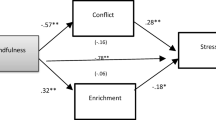Abstract
Based upon Antonovsky's conceptual model of resources as resistors to stress, seven personal and three environmental resistance resources are identified, and quantified. The resistance resources and measure of tension are used as the predictor variables in a stepwise multiple regression analysis to identify the factors which best predict stress. The four variables which are statistically significant in explaining variance in stress scores are satisfaction with family life, total number of life events experienced, age, and satisfaction with family finances.
Similar content being viewed by others
References
Antonovsky, A. (1985).Health, stress, and coping. San Francisco: Jossey-Bass.
Ballard, P., & Fuguitt, G. (1985). The changing small town settlement structure in the United States, 1900–1980.Rural Sociology, 50 99–113.
Baum, A., Singer, J., & Baum, C. (1982). Stress and the environment. In G.W. Evans (Ed.),Environmental stress (pp. 15–44). New York: Cambridge University Press.
Bender, L., Green, B., Hady, T., Kuehn, J., Nelson, M., Perkinson, L., & Ross, P. (1985).The diverse social and economic structure of nonmetropolitan America (Rural Development Research Report No. 49). Washington, DC: U.S. Department of Agriculture, Economic Research Service, Agriculture and Rural Economics Division.
Bradshaw, T., & Blakely, E. (1982). The changing nature of rural America.Policy Studies Review, 2(1), 12–25.
Cohen, S., Karmarck, T., & Mermelstein, R. (1983). A global measure of perceived stress.Journal of Health and Social Behavior, 24 385–396.
Costa, P., & McCrae, R. (1983). Contribution of personality research to an understanding of stress and aging.Marriage and Family Review, 6(1/2), 157–173.
Dobra, J., Atkinson, G., & Barone, R. (1983).An analysis of the economic impact of the mining industry on Nevada's economy. Reno: University of Nevada Reno, College of Business Administration, Bureau of Business Economic Research.
Haldeman, V., & Peters, J. (1987).Three coping styles: A factor analysis of the Moos Coping Scale. Unpublished manuscript.
Haldeman, V., Peters, J., & Martin, S. (1986). An analysis of perceived economic and psycho-social well-being of rural Nevada residents with and without investment income. In M. Ordman (Ed.),Proceedings of the International Association for Financial Planning Academic Symposium (pp. 37–50). Chicago, IL.
Moos, R., & Schaefer, J. (1986). Life transitions and crises: A conceptual overview. In R.H. Moos (Ed.),Coping with life crises: An integrated approach (pp. 3–28). New York: Plenum.
Pearlin, L., & Schooler, C. (1978). The structure of coping.Journal of Health and Social Behavior, 19 2–21.
Preston, D., & Mansfield, P. (1984). An exploration of stressful life events, illness, and coping among the rural elderly.The Gerontologist, 24 490–494.
Toll, D. (1981).The complete Nevada traveler: A guide to the state. Gold Hill, NV: Gold Hill Publishing Company.
Waterhouse, I. (1984). Presidential address: Perspectives on stress, coping, and vulnerability.Australian Psychologist, 19(2), 115–133.
Author information
Authors and Affiliations
Additional information
This project was part of the W-167 Western Regional Agricultural Experiment Station Project, Coping with Stress: Adaptation of Nonmetropolitan Families to Socioeconomic Changes, and was partially funded by the Nevada Agricultural Experiment Station. The original instrument was developed and the first wave of data was collected by Dr. Judith Zimmerman, former faculty member of the School of Home Economics at the University of Nevada-Reno.
Virginia A. Haldeman is Associate Professor, School of Home Economics, University of Nevada-Reno, Reno, NV 89557. She received her Ed.D. from Utah State University and her research interests include stress and conservation practices.
Jeanne M. Peters received her Ph.D. from Oregon State University. She is Assistant Professor, School of Home Economics, University of Nevada-Reno, Reno, NV 89557. Research interests include stress and time use.
Rights and permissions
About this article
Cite this article
Haldeman, V.A., Peters, J.M. Using resistance resources to reduce stress: A study of rural Nevadans. J Fam Econ Iss 9, 357–366 (1988). https://doi.org/10.1007/BF00986751
Issue Date:
DOI: https://doi.org/10.1007/BF00986751




